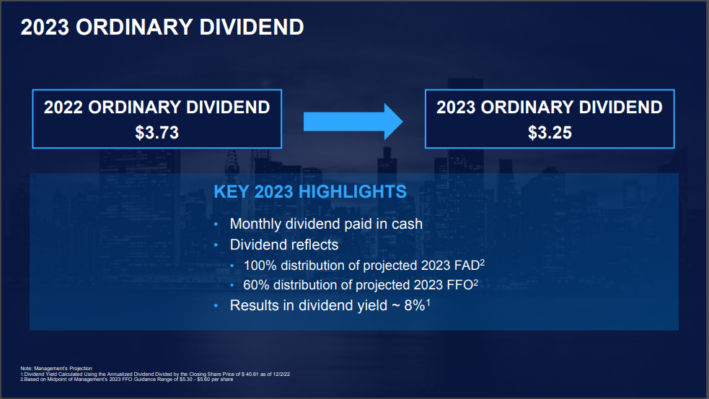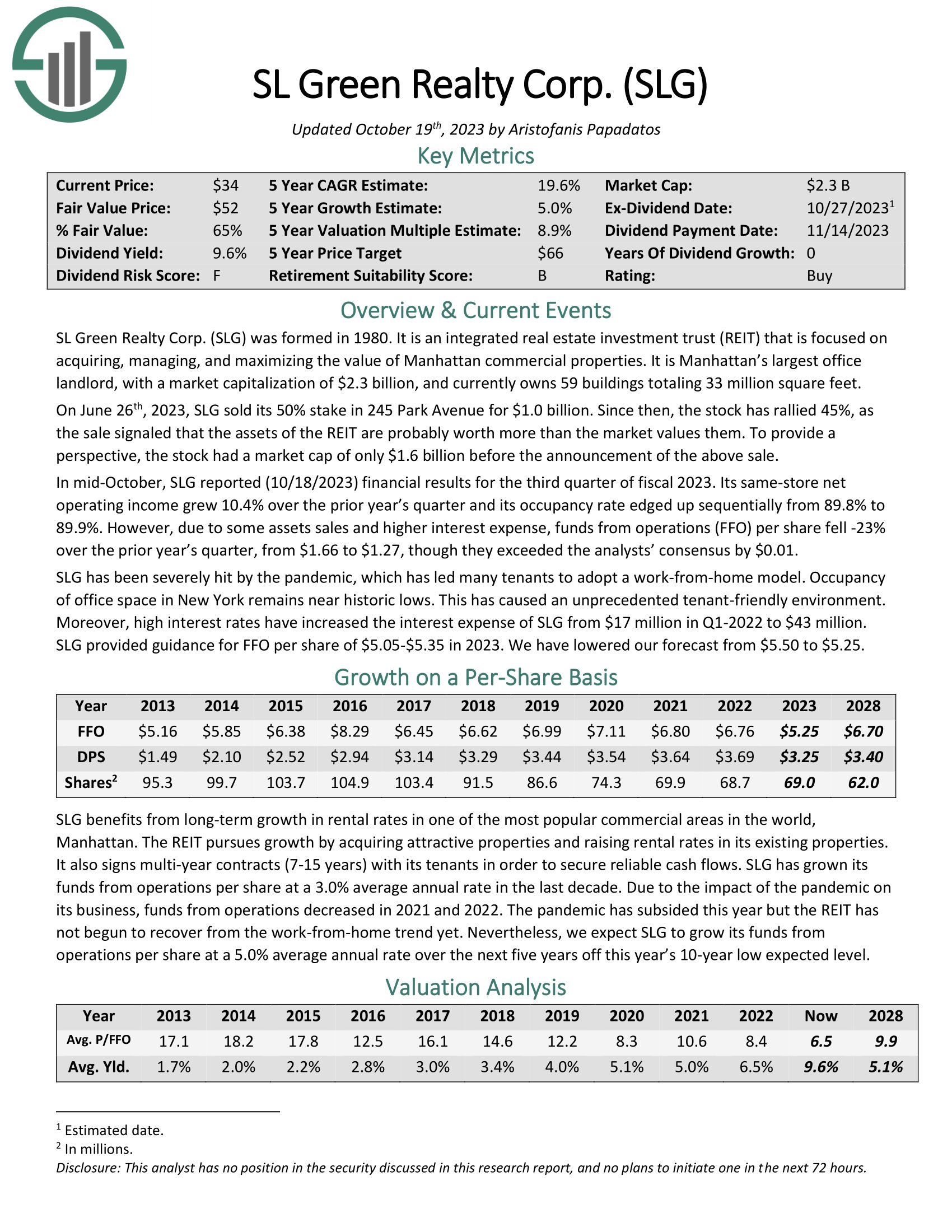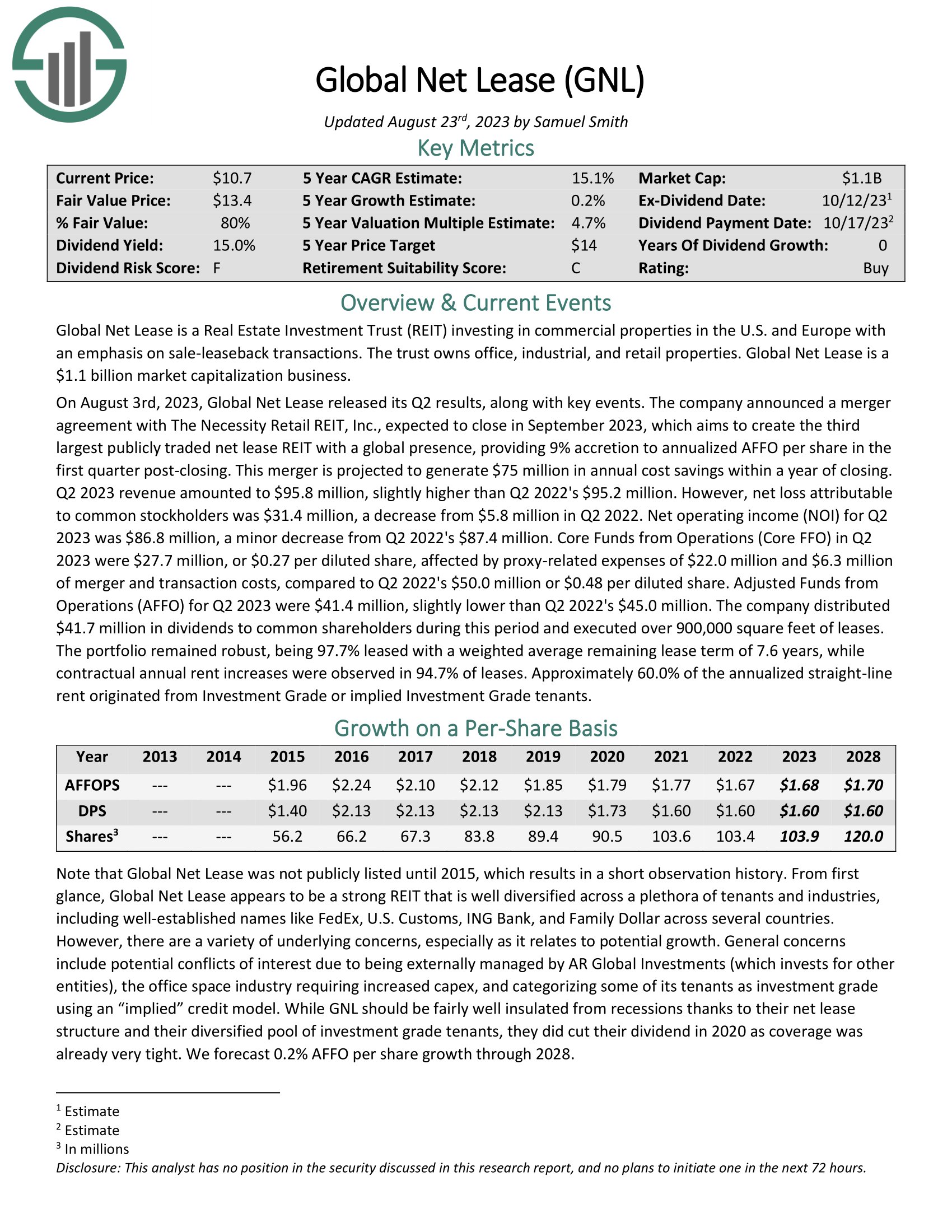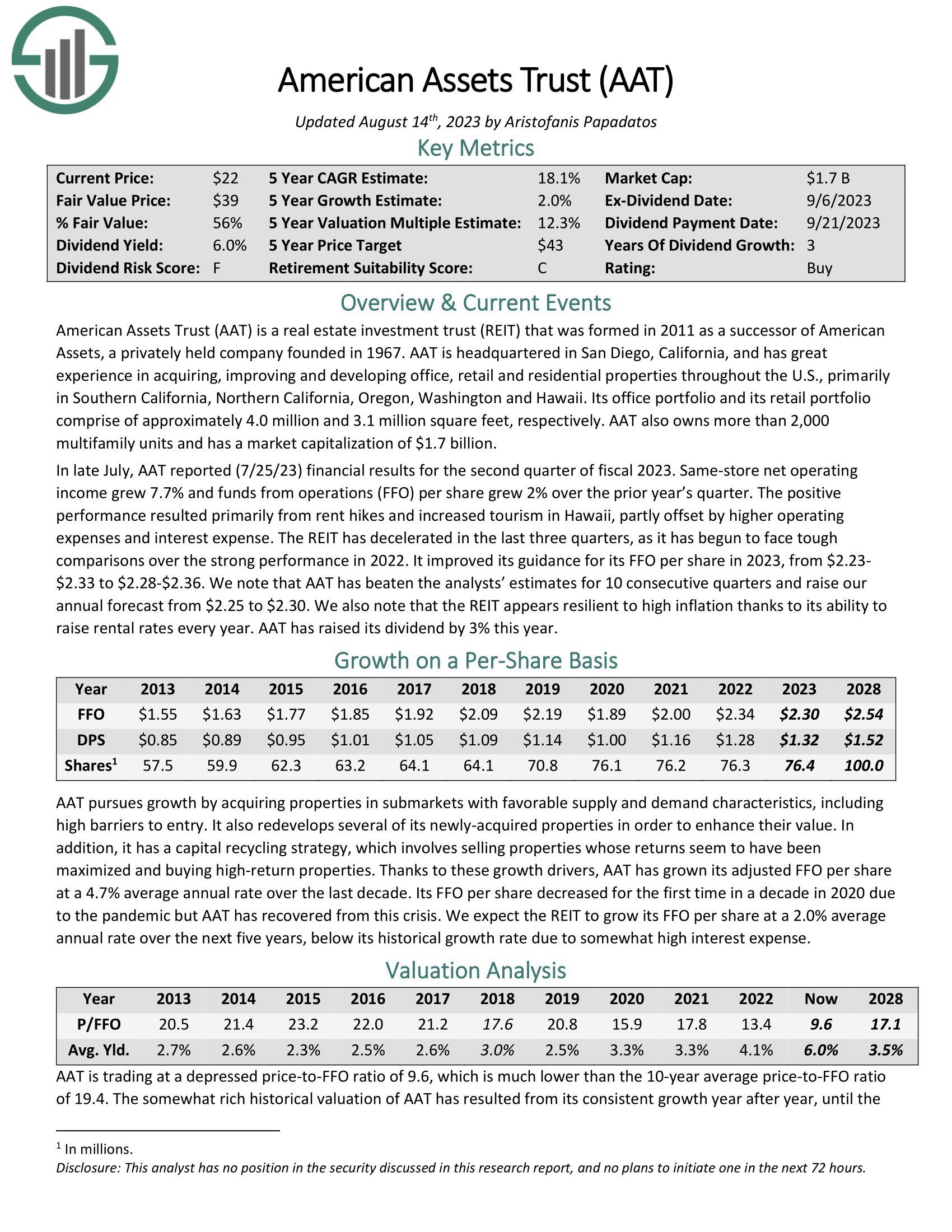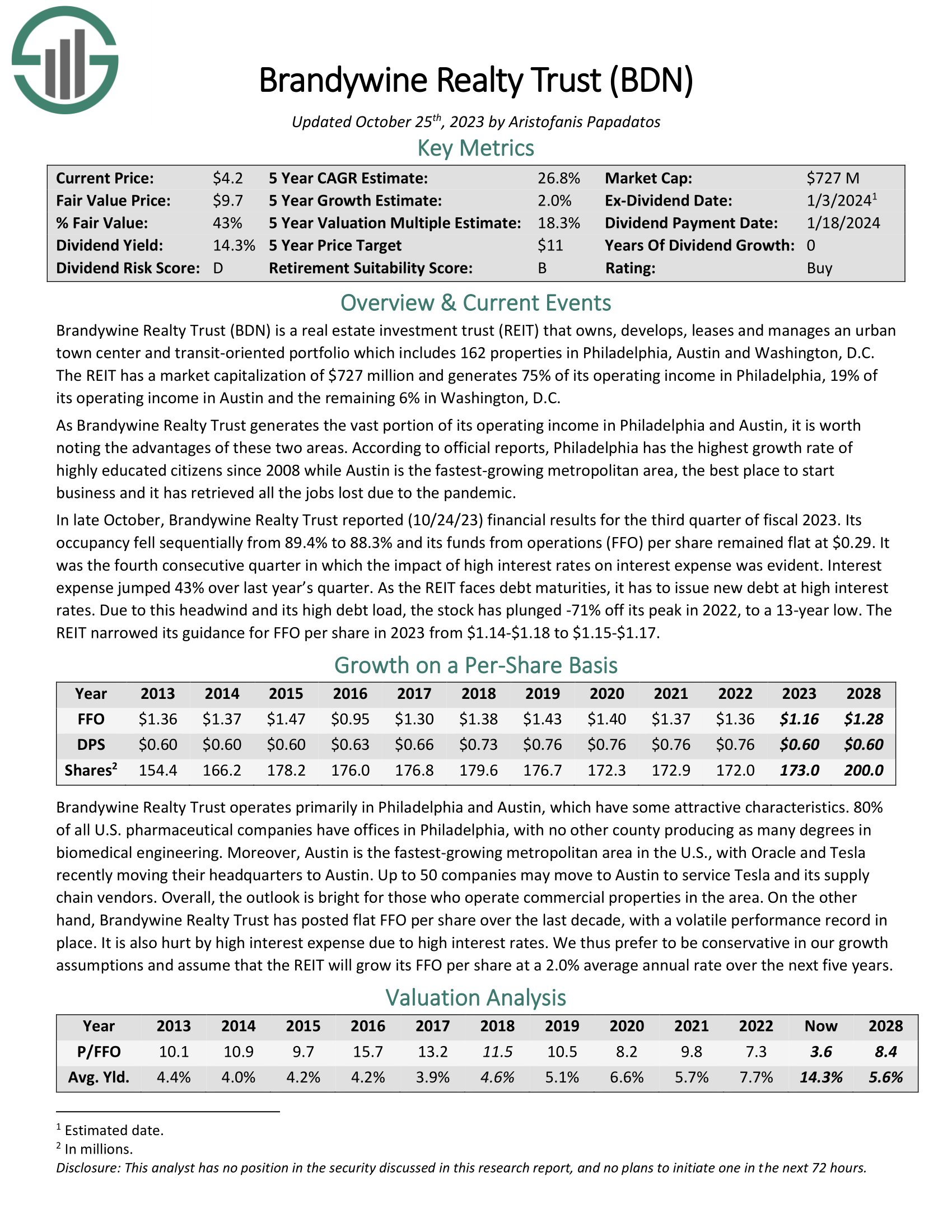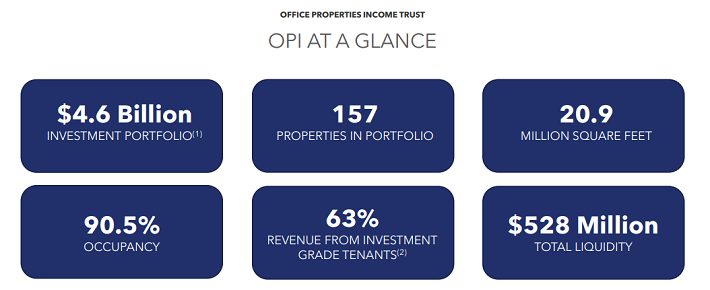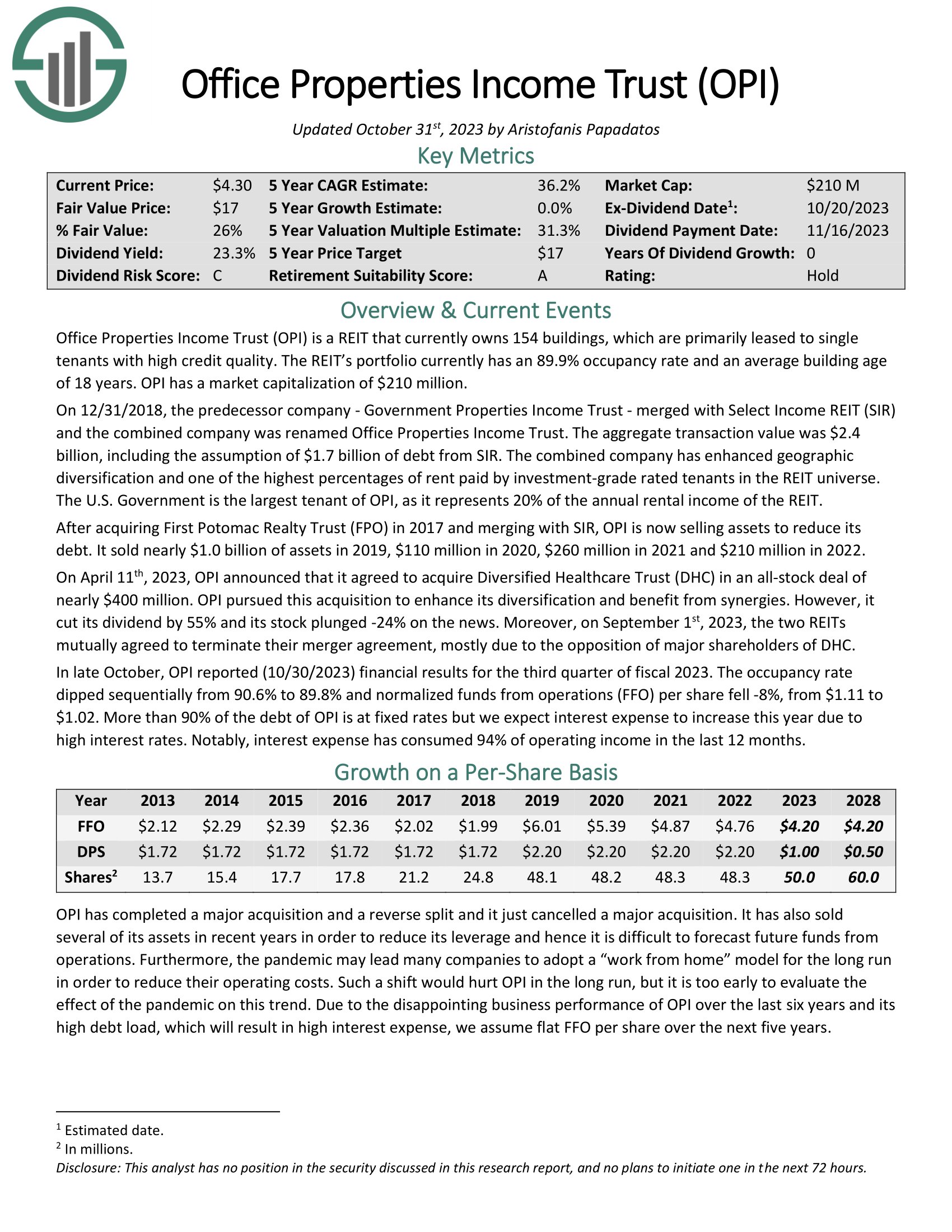Updated on November 9th, 2023 by Bob Ciura
Spreadsheet data updated daily
Real estate investment trusts – or REITs, for short – can be fantastic securities for generating meaningful portfolio income. REITs widely offer higher dividend yields than the average stock.
While the S&P 500 Index on average yields less than 2% right now, it is relatively easy to find REITs with dividend yields of 5% or higher.
The following downloadable REIT list contains a comprehensive list of U.S. Real Estate Investment Trusts, along with metrics that matter including:
- Stock price
- Dividend yield
- Market capitalization
- 5-year beta
You can download your free 200+ REIT list (along with important financial metrics like dividend yields and payout ratios) by clicking on the link below:
In addition to the downloadable Excel sheet of all REITs, this article discusses why income investors should pay particularly close attention to this asset class. And, we also include our top 7 REITs today based on expected total returns.
Table Of Contents
In addition to the full downloadable Excel spreadsheet, this article covers our top 7 REITs today, as ranked using expected total returns from The Sure Analysis Research Database.
The table of contents below allows for easy navigation.
How To Use The REIT List To Find Dividend Stock Ideas
REITs give investors the ability to experience the economic benefits associated with real estate ownership without the hassle of being a landlord in the traditional sense.
Because of the monthly rental cash flows generated by REITs, these securities are well-suited to investors that aim to generate income from their investment portfolios. Accordingly, dividend yield will be the primary metric of interest for many REIT investors.
For those unfamiliar with Microsoft Excel, the following images show how to filter for high dividend REITs with dividend yields between 5% and 7% using the ‘filter’ function of Excel.
Step 1: Download the Complete REIT Excel Spreadsheet List at the link above.
Step 2: Click on the filter icon at the top of the ‘Dividend Yield’ column in the Complete REIT Excel Spreadsheet List.

Step 3: Use the filter functions ‘Greater Than or Equal To’ and ‘Less Than or Equal To’ along with the numbers 0.05 ad 0.07 to display REITs with dividend yields between 5% and 7%.
This will help to eliminate any REITs with exceptionally high (and perhaps unsustainable) dividend yields.
Also, click on ‘Descending’ at the top of the filter window to list the REITs with the highest dividend yields at the top of the spreadsheet.
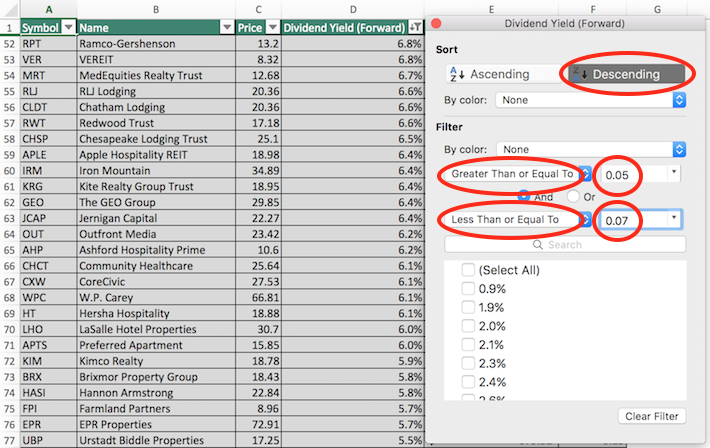
Now that you have the tools to identify high-quality REITs, the next section will show some of the benefits of owning this asset class in a diversified investment portfolio.
Why Invest in REITs?
REITs are, by design, a fantastic asset class for investors looking to generate income.
Thus, one of the primary benefits of investing in these securities is their high dividend yields.
The currently high dividend yields of REITs is not an isolated occurrence. In fact, this asset class has traded at a higher dividend yield than the S&P 500 for decades.
Related: Dividend investing versus real estate investing.
The high dividend yields of REITs are due to the regulatory implications of doing business as a real estate investment trust.
In exchange for listing as a REIT, these trusts must pay out at least 90% of their net income as dividend payments to their unitholders (REITs trade as units, not shares).
Sometimes you will see a payout ratio of less than 90% for a REIT, and that is likely because they are using funds from operations, not net income, in the denominator for REIT payout ratios (more on that later).
REIT Financial Metrics
REITs run unique business models. More than the vast majority of other business types, they are primarily involved in the ownership of long-lived assets.
From an accounting perspective, this means that REITs incur significant non-cash depreciation and amortization expenses.
How does this affect the bottom line of REITs?
Depreciation and amortization expenses reduce a company’s net income, which means that sometimes a REIT’s dividend will be higher than its net income, even though its dividends are safe based on cash flow.
Related: How To Value REITs
To give a better sense of financial performance and dividend safety, REITs eventually developed the financial metric funds from operations, or FFO.
Just like earnings, FFO can be reported on a per-unit basis, giving FFO/unit – the rough equivalent of earnings-per-share for a REIT.
FFO is determined by taking net income and adding back various non-cash charges that are seen to artificially impair a REIT’s perceived ability to pay its dividend.
For an example of how FFO is calculated, consider the following net income-to-FFO reconciliation from Realty Income (O), one of the largest and most popular REIT securities.
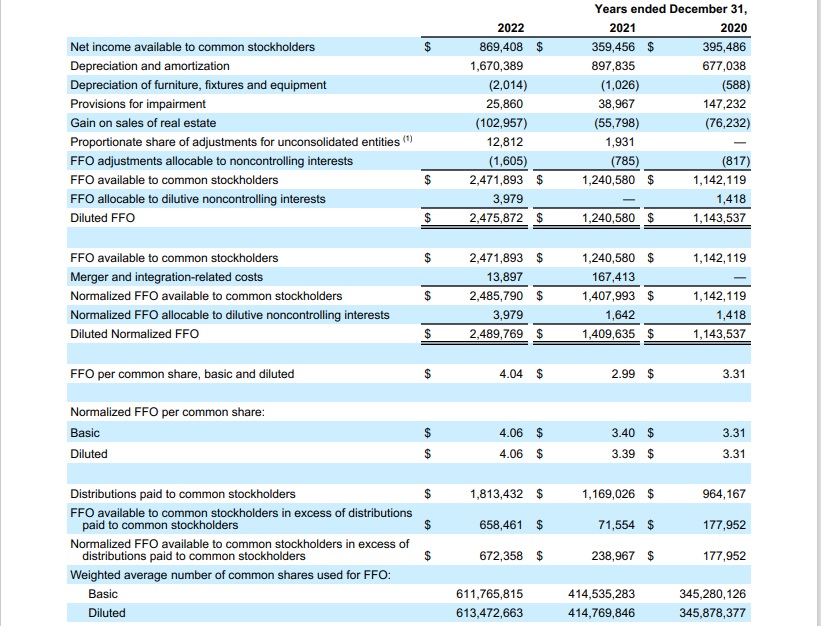
Source: Realty Income Annual Report
In 2022, net income was $869 million while FFO available to stockholders was above $2.4 billion, a sizable difference between the two metrics. This shows the profound effect that depreciation and amortization can have on the GAAP financial performance of real estate investment trusts.
The Top 7 REITs Today
Below we have ranked our top 7 REITs today based on expected total returns.
Expected total returns are in turn made up from dividend yield, expected growth on a per unit basis, and valuation multiple changes. Expected total return investing takes into account income (dividend yield), growth, and value.
Note: The REITs below have not been vetted for safety. These are high expected total return securities, but they may come with elevated risks.
We encourage investors to fully consider the risk/reward profile of these investments.
For the Top 10 REITs each month with 4%+ dividend yields, based on expected total returns and safety, see our Top 10 REITs service.
Top REIT #7: SL Green Realty (SLG)
- Expected Total Return: 20.8%
- Dividend Yield: 10.1%
SL Green is a self-managed REIT that manages, acquires, develops, and leases New York City Metropolitan office properties. In fact, the trust is the largest owner of office real estate in New York City, with the majority of its properties located in midtown Manhattan. It is Manhattan’s largest office landlord, with 60 buildings totaling about 33 million square feet.
Source: Investor Presentation
In mid-October, SLG reported (10/18/2023) financial results for the third quarter of fiscal 2023. Its same-store net operating income grew 10.4% over the prior year’s quarter and its occupancy rate edged up sequentially from 89.8% to 89.9%. However, due to some assets sales and higher interest expense, funds from operations (FFO) per share fell -23% over the prior year’s quarter, from $1.66 to $1.27, though they exceeded the analysts’ consensus by $0.01.
Click here to download our most recent Sure Analysis report on SL Green Realty Corp. (SLG) (preview of page 1 of 3 shown below):
Top REIT #6: Global Net Lease (GNL)
- Expected Total Return: 21.0%
- Dividend Yield: 19.3%
Global Net Lease invests in commercial properties in the U.S. and Europe with an emphasis on sale-leaseback transactions. The trust owns well in excess of 300 properties, of which office is the largest sector, followed by industrial and retail. Global Net Lease is a $1.1 billion market capitalization business.
On August 3rd, 2023, Global Net Lease released its Q2 results. The company announced a merger agreement with The Necessity Retail REIT, Inc., expected to close in September 2023, which aims to create the third largest publicly traded net lease REIT with a global presence, providing 9% accretion to annualized AFFO per share in the first quarter post-closing. This merger is projected to generate $75 million in annual cost savings within a year of closing.
Click here to download our most recent Sure Analysis report on Global Net Lease (GNL) (preview of page 1 of 3 shown below):
Top REIT #5: American Assets Trust (AAT)
- Expected Total Return: 21.5%
- Dividend Yield: 7.0%
American Assets Trust acquires and develops office, retail and residential properties throughout the U.S., primarily in Southern California, Northern California, Oregon, Washington and Hawaii.
Its office portfolio and its retail portfolio comprise of approximately 4.0 million and 3.1 million square feet, respectively. AAT also owns more than 2,000 multifamily units.
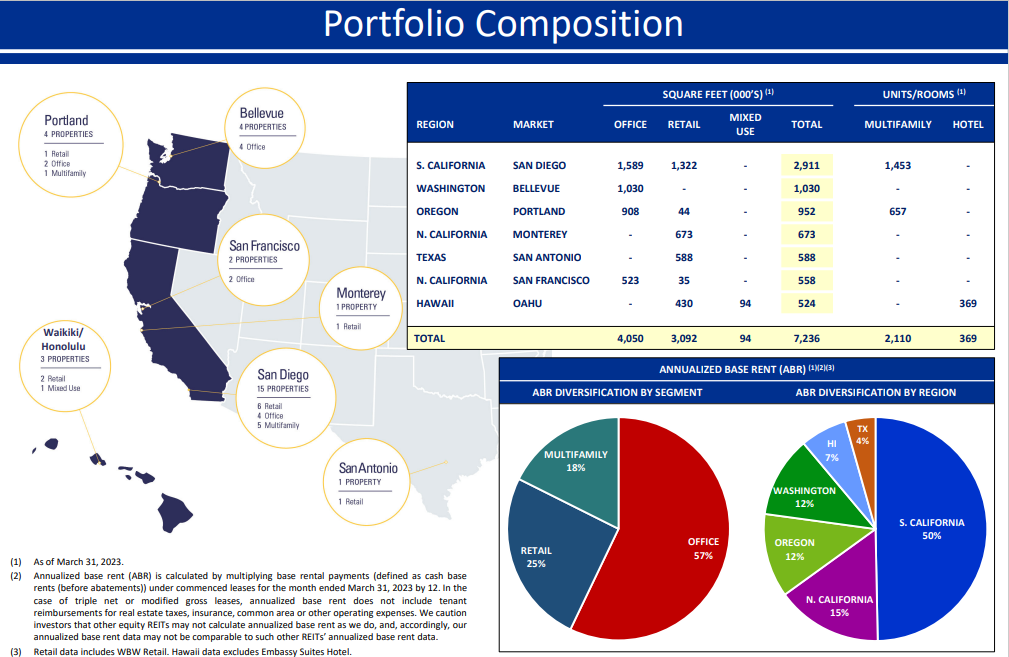
Source: Investor Presentation
In late July, AAT reported (7/25/23) financial results for the second quarter of fiscal 2023. Same-store net operating income grew 7.7% and funds from operations (FFO) per share grew 2% over the prior year’s quarter.
The positive performance resulted primarily from rent hikes and increased tourism in Hawaii, partly offset by higher operating expenses and interest expense. It improved its guidance for its FFO per share in 2023, from $2.23- $2.33 to $2.28-$2.36.
Click here to download our most recent Sure Analysis report on AAT (preview of page 1 of 3 shown below):
Top REIT #4: Douglas Emmett Realty (DEI)
- Expected Total Return: 21.5%
- Dividend Yield: 6.3%
Douglas Emmett is a real estate investment trust (REIT) that was founded in 1971. It is the largest office landlord in Los Angeles and Honolulu, with a 38% average market share of office space in its submarkets. The REIT generates 80% of its revenue from its office portfolio and 20% of its revenue from its multifamily portfolio. It has approximately 2,700 office leases in its portfolio, annual revenue of $1 billion and a market capitalization of $2.2 billion.
In late October, Douglas Emmett reported (10/31/23) financial results for the third quarter of fiscal 2023. Revenue grew 0.7% thanks to higher tenant recoveries but adjusted funds from operations (FFO) per share dipped -15% over the prior year’s quarter due to increased interest expense. Management reiterated its guidance for FFO per share of $1.81-$1.85 in 2023, as high interest rates will continue weighing on interest expense..
Click here to download our most recent Sure Analysis report on DEI (preview of page 1 of 3 shown below):

Top REIT #3: Clipper Properties (CLPR)
- Expected Total Return: 22.1%
- Dividend Yield: 7.6%
Clipper Properties owns commercial (primarily multifamily and office with a small sliver of retail) real estate across New York City.
On August 3rd, Clipper Properties released its second-quarter results. The company achieved record quarterly revenues of $34.5 million and income from operations of $8.0 million during the second quarter of 2023. Notably, there was also a record net operating income (“NOI”) of $19.2 million for the same period.
However, the company reported a net loss of $3.3 million for the second quarter. Additionally, the quarterly adjusted funds from operations (“AFFO”) amounted to $5.5 million.
Click here to download our most recent Sure Analysis report on CLPR (preview of page 1 of 3 shown below):
Top REIT #2: Brandywine Realty Trust (BDN)
- Expected Total Return: 28.3%
- Dividend Yield: 15.2%
Brandywine Realty owns, develops, leases and manages an urban town center and transit-oriented portfolio which includes 163 properties in Philadelphia, Austin and Washington, D.C. The REIT has a market capitalization of $1.1 billion and generates 74% of its operating income in Philadelphia, 22% of its operating income in Austin and the remaining 4% in Washington, D.C.
In late October, Brandywine Realty Trust reported (10/24/23) financial results for the third quarter of fiscal 2023. Its occupancy fell sequentially from 89.4% to 88.3% and its funds from operations (FFO) per share remained flat at $0.29. It was the fourth consecutive quarter in which the impact of high interest rates on interest expense was evident.
Interest expense jumped 43% over last year’s quarter. As the REIT faces debt maturities, it has to issue new debt at high interest rates. Due to this headwind and its high debt load, the stock has plunged -71% off its peak in 2022, to a 13-year low. The REIT narrowed its guidance for FFO per share in 2023 from $1.14-$1.18 to $1.15-$1.17.
Click here to download our most recent Sure Analysis report on BDN (preview of page 1 of 3 shown below):
Top REIT #1: Office Properties Income Trust (OPI)
- Expected Total Return: 32.3%
- Dividend Yield: 19.9%
Office Properties Income Trust is a REIT that currently owns 157 buildings, which are primarily leased to single tenants with high credit quality. The REIT’s portfolio currently has a 90.5% occupancy rate.
In late October, OPI reported (10/30/2023) financial results for the third quarter of fiscal 2023. The occupancy rate dipped sequentially from 90.6% to 89.8% and normalized funds from operations (FFO) per share fell -8%, from $1.11 to $1.02.
More than 90% of the debt of OPI is at fixed rates but we expect interest expense to increase this year due to high interest rates. Notably, interest expense has consumed 94% of operating income in the last 12 months.
Click here to download our most recent Sure Analysis report on OPI (preview of page 1 of 3 shown below):
Final Thoughts
The REIT Spreadsheet list in this article contains a list of publicly-traded Real Estate Investment Trusts.
However, this database is certainly not the only place to find high-quality dividend stocks trading at fair or better prices.
In fact, one of the best methods to find high-quality dividend stocks is looking for stocks with long histories of steadily rising dividend payments. Companies that have increased their payouts through many market cycles are highly likely to continue doing so for a long time to come.
You can see more high-quality dividend stocks in the following Sure Dividend databases, each based on long streaks of steadily rising dividend payments:
You might also be looking to create a highly customized dividend income stream to pay for life’s expenses.
The following lists provide useful information on high dividend stocks and stocks that pay monthly dividends:
Thanks for reading this article. Please send any feedback, corrections, or questions to support@suredividend.com.






